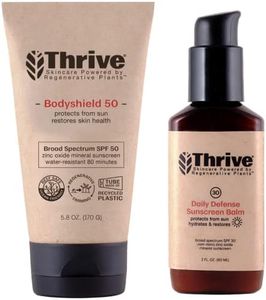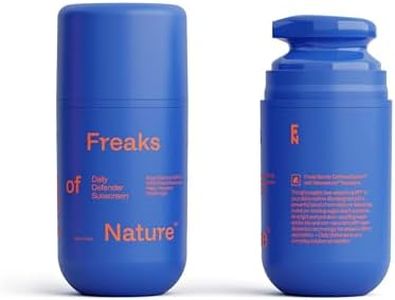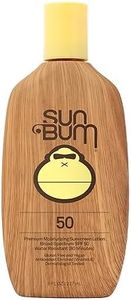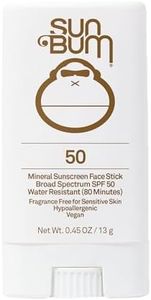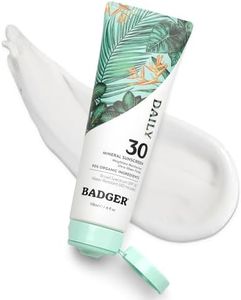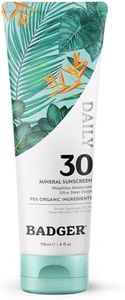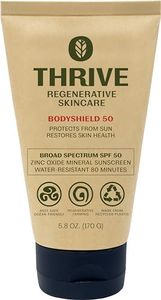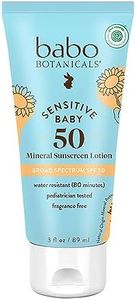10 Best Reef Safe Sunscreen Hawaii 2025 in the United States
Our technology thoroughly searches through the online shopping world, reviewing hundreds of sites. We then process and analyze this information, updating in real-time to bring you the latest top-rated products. This way, you always get the best and most current options available.

Our Top Picks
Winner
Sun Bum Original SPF 70 Sunscreen Body Spray - Broad Spectrum Moisturizing Sunscreen with Vitamin E - Hawaii 104 Act Compliant (Made without Octinoxate & Oxybenzone) - 6 oz
Most important from
26694 reviews
The Sun Bum Original SPF 70 Sunscreen Spray is a vegan, reef-safe option that complies with Hawaii's 104 Reef Act, as it is free from harmful chemicals like Octinoxate and Oxybenzone. It promises broad-spectrum protection, shielding your skin from both UVA and UVB rays. With its SPF 70 rating, it offers a high level of protection, making it suitable for prolonged sun exposure. The sunscreen is also water-resistant for up to 80 minutes, which is great for swimming or sweating.
Be mindful to reapply it every two hours for continuous protection. The spray application makes it easy to use, though care should be taken to avoid the eye area. Additionally, it is enriched with Vitamin E, which helps to moisturize the skin, and it's non-comedogenic, meaning it won't clog pores. Users appreciate its pleasant scent, often described as smelling like summer.
Despite its many benefits, some users might find the price on the higher side, and the spray form may not be as environmentally friendly due to aerosol usage. Nonetheless, it's an effective and convenient choice for those looking for strong sun protection without harming marine life.
Most important from
26694 reviews
Sun Bum Original SPF 50 Sunscreen Body Spray - Broad Spectrum Moisturizing Sunscreen with Vitamin E - Hawaii 104 Act Compliant (Made without Octinoxate & Oxybenzone) - 6 oz
Most important from
26694 reviews
Sun Bum Original SPF 50 Sunscreen Body Spray is a solid choice for those looking for broad-spectrum sun protection that is safe for Hawaii’s reefs. It protects against both UVA and UVB rays with SPF 50, which is strong enough for most outdoor activities. The spray format makes it easy and quick to apply, especially over large areas of the body. This sunscreen is free of harmful chemicals like oxybenzone and octinoxate, ingredients known to damage coral reefs, so it meets Hawaii’s 104 Act standards for reef safety.
Another plus is that it’s oil-free, non-comedogenic, and includes Vitamin E, which helps moisturize the skin rather than drying it out. It is also water-resistant, lasting up to 80 minutes in water or sweat, which is convenient for beachgoers and swimmers. However, like most sunscreens, it needs to be reapplied every two hours to maintain protection, and some users might find spray sunscreens a bit tricky to apply evenly compared to lotions. Also, while it is designed for all skin types, those with very sensitive skin should still test it first.
This sunscreen effectively combines sun defense with skin-friendly ingredients and environmental care, making it a suitable pick for outdoor enthusiasts and anyone wanting to protect their skin and local reefs.
Most important from
26694 reviews
Daily Defender SPF 30 | 100% Mineral Sunscreen | Lightweight, Fast-Absorbing, 40-Min Water-Resistant | Plant-Based, Eco-Friendly, Reef-Safe, Cruelty-Free | All Skin Types | 1.7 oz I Pack of 2
Most important from
190 reviews
The Daily Defender SPF 30 is a 100% mineral sunscreen that offers broad-spectrum protection against UVA and UVB rays, making it suitable for various outdoor activities and daily use. Its active ingredients are plant-based, ensuring eco-friendliness and compliance with Hawaii’s Reef Compliant Act 104, which helps protect marine life. The sunscreen is lightweight, fast-absorbing, and does not leave a white cast, which is a common issue with many mineral sunscreens.
It provides 40 minutes of water resistance, making it a reliable option for beach outings and water sports. Additionally, it is enriched with Neossance Vegan Shark Squalane and B-Silk Vegan Spider Silk Protein, which hydrate and nourish the skin, supporting a healthy microbiome and leaving the skin glowing. This product is dermatologist-tested, cruelty-free, and packaged in 100% recycled, ocean-bound plastic, aligning with sustainable and eco-conscious values.
However, the product’s relatively small size (1.7 oz per bottle) might require frequent repurchases for regular users. Also, while it is fragrance-free, those with sensitive skin should conduct a patch test to ensure there are no adverse reactions. This sunscreen is ideal for individuals looking for an eco-friendly, effective, and hydrating sunscreen suited for everyday use and outdoor activities.
